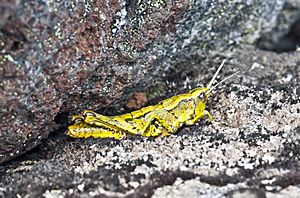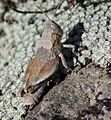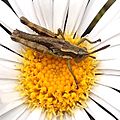Sigaus facts for kids
Quick facts for kids Sigaus |
|
|---|---|
 |
|
| Sigaus piliferus | |
| Scientific classification |
|
| Kingdom: | Animalia |
| Phylum: | Arthropoda |
| Class: | Insecta |
| Order: | Orthoptera |
| Suborder: | Caelifera |
| Family: | Acrididae |
| Tribe: | Catantopini |
| Genus: | Sigaus Hutton, 1897 |
| Species | |
|
Sigaus australis |
|
Sigaus is a group of grasshoppers found only in New Zealand. This means they are endemic to New Zealand, living nowhere else in the world. Most Sigaus species live on the South Island. Only one, Sigaus piliferus, lives on the North Island. It is also the first species discovered in this group.
There are eight different species of Sigaus grasshoppers. All of them are flightless, meaning they cannot fly. Many of these grasshoppers have special colours that help them blend in with rocky ground, which is called camouflage. Sadly, two species, Sigaus minutus and S. childi, are in danger of disappearing forever.
Contents
What are Sigaus Grasshoppers?
Sigaus grasshoppers belong to a larger family of insects called Acrididae, which includes many types of grasshoppers and locusts. These insects are known for their strong back legs, which they use to jump far.
Where Do They Live?
Most Sigaus grasshoppers live in the South Island of New Zealand. They can be found in different places, from dry, rocky hillsides to high mountain areas. For example:
- Sigaus australis and Sigaus obelisci live in high places, often over 1,300 meters (4,300 feet) above sea level.
- Sigaus childi prefers lower, dry rocky hillsides, around 200–500 meters (660–1,600 feet).
- Sigaus piliferus, the only North Island species, lives in tussock grasslands across many regions.
How Big Are They?
The size of Sigaus grasshoppers can vary:
- Some are quite small, like Sigaus minutus, which is very tiny.
- Others are medium-sized, such as Sigaus australis.
- Some are large, like Sigaus piliferus and Sigaus villosus.
Even though they are grasshoppers, Sigaus species have very small wings, usually only 1 to 4 millimeters long. These small wings are why they cannot fly.
Life and Survival
Sigaus grasshoppers have special ways to survive in their environments. Their camouflage helps them hide from predators like birds and lizards.
Camouflage and Appearance
Many Sigaus species are highly cryptic, which means they are very good at blending into their surroundings. Their colours and patterns often match the rocks, soil, or plants where they live. This makes them very hard to spot!
Habitat and Diet
These grasshoppers live in various habitats across New Zealand:
- Many species, like Sigaus australis and Sigaus homerensis, live in tussock grasslands. Tussock is a type of grass that grows in clumps.
- Others, such as Sigaus childi and Sigaus campestris, prefer dry, rocky hillsides.
- Sigaus obelisci lives in unique alpine lichen fields, which are high-altitude areas with small plants called lichens.
- Sigaus villosus is found in scree, which are slopes covered in loose, broken rocks.
Like most grasshoppers, Sigaus species are herbivores, meaning they eat plants. They likely feed on the grasses and other small plants found in their specific habitats.
Conservation Status
Some Sigaus grasshoppers are facing serious threats and need protection.
- Sigaus childi is listed as Nationally Critical, meaning it is extremely close to extinction.
- Sigaus minutus is Nationally Endangered, also facing a very high risk of extinction.
- Other species, like Sigaus homerensis, Sigaus obelisci, and Sigaus takahe, are considered Range Restricted. This means they only live in a small area, which makes them more vulnerable to changes in their environment.
- Luckily, species like Sigaus australis, Sigaus campestris, Sigaus piliferus, and Sigaus villosus are currently not considered threatened.
Protecting their habitats and understanding more about these unique flightless grasshoppers is important to ensure they continue to thrive in New Zealand.
Images for kids









